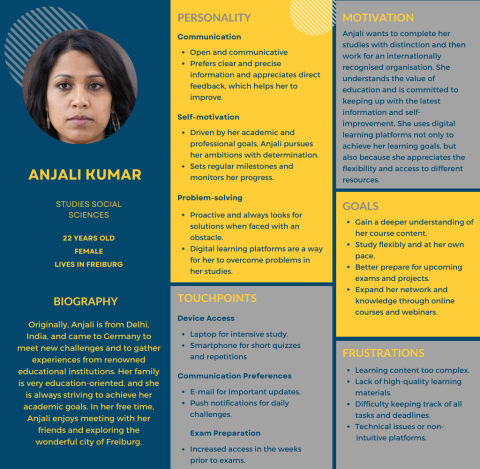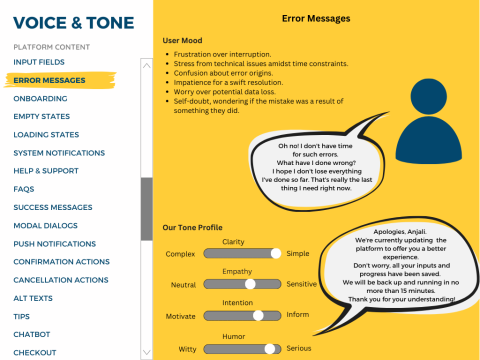Table of contents
1. Lost in space
2. Who is your target group?
3. From abstract target groups to tangible personas
4. UX writing: An indispensable dialogue with your target group
5. Shaping digital interaction with words
6. Tone and voice: creating a consistent user experience
7. Practical usage: How tone and voice work in dialogue with users
8. Mastering dynamics through adaptability
9. Target group-specific user testing
10. Testing, checking, optimising: The ongoing dialogue in user testing
1. Lost in space
Focusing on the needs of the target audience is a key aspect of business success. However, half-hearted approaches often creep into business strategies. Why? Perhaps due to the following alluring assumption: ‘We are so impressed by our product that it simply must blow you away too!’ But be cautious – that is a dangerous mistake. Something that seems great internally does not necessarily reflect the needs of the market.
‘The more the merrier’ often proves to be a misconception, as communication that is too broad and wishy-washy is risky and often results in the message being lost in the noise. ‘You can’t please everyone’ – this phrase hits the nail on the head. Precise and targeted delivery of your message is key, as a one-size-fits-all approach actually waters it down and stands in the way of true success. Without a clear focus on the needs of the target group, the success companies hope for is often simply a pipe dream.
2. Who is your target group?
So, have you thought carefully about who you actually want to address? Lay a solid foundation to build on.
- Developing a deep understanding: Do you really know what makes your potential target group tick? It is crucial to not just look at the market superficially but to go into depth. Find out exactly where the pain points and unmet market needs lie. Then you can offer solutions that really make a difference.
- Appealing to the right people: Not everyone will need or value your product – and that’s perfectly fine. It’s almost impossible to develop a product or service that appeals to or benefits absolutely everyone in the market. In the age of social media, it is easier than ever to have your finger on the pulse and to understand exactly what your potential customers want and need. Use market analyses, customer surveys and research consumer behaviour to precisely define your target group and optimally deploy your resources. This allows you to pinpoint your brand message and reach the people who would most benefit from what you have to offer.
3. From abstract target groups to tangible personas
It is important that you don’t just have a vague idea of your target group, but that you really know and understand them. This is where personas come in, as they are a direct representation of your target group. Personas are therefore not just simply nice personal descriptions, but rather they are based on well-founded profiles that draw upon real data and insights into your customers. They help you to see the people behind the numbers and to appeal to them more effectively.
Why personas are so valuable:
- If you know the exact needs of your target group, you can not only customise your offer but tailor it perfectly to them. Don’t just serve your customers. Instead, inspire them and make them feel that you understand exactly what they need and want.
- Detailed personas enable a personalised approach. Address your customers in their own language. With detailed personas at hand, you can communicate authentically with your target group. Don’t just create trust, but also establish a close relationship between the customer and your brand. Listen and give them the right answers.
- A deep understanding of your target group will also help you avoid costly mistakes in product development and make smart, informed decisions.

Figure 1: Persona example
4. UX writing: An indispensable dialogue with your target group
Designing your marketing activities specifically for certain target groups is only the first step. Direct, clear and supportive communication with your users throughout the entire course of their interaction with your product or service is just as important. This is where UX writing comes into play, a discipline that plays an indispensable role in the user experience. Especially for digital services, SaaS products or offers that are sold online, it is essential that you not only impress the users during initial contact but also that you support them and correctly address their needs throughout the entire period of use. This continuous support is what builds trust and ensures customer loyalty.
Let’s take a practical example: imagine you are filling out your tax return on an online platform. After hours of entering your information, you receive the following message: ‘Oi oi, we’ve had a gander at your tax entries – everything’s looking bang-on!’ Excuse me? Using this type of slang, which might appeal to a younger target group, could annoy people who expect more formal and professional communication from a tax platform. A message like this quickly undermines trust in the platform’s seriousness. Harmonised UX writing is essential to avoid such misunderstandings and strengthen the trust of the target group.

Figure 2: Writing gone wrong
5. Shaping digital interaction with words
Good UX writers not only understand the language of their target group, but also their pain points, desires, and needs. They think in terms of user journeys, anticipate potential pitfalls and find the right words – not only to inform but also to motivate and excite.
They are able to communicate complex issues in a simple and easy-to-understand manner, meaning the customers feel they are in good hands and that they are understood. The skills of UX writers are often the deciding factor in determining whether an application is used with enjoyment or abandoned in frustration.
Despite this key role, the true value of experienced UX writers is still not fully recognised in many companies. Not all specialists involved in text-focused professions are suited as UX writers or have the necessary skills. UX writing is more than simply good spelling and clear phrasing– it is about hitting the exact tone, voice and emotion that appeals to the target group and resonates with the brand. A tone and voice profile needs to be carefully developed in advance in order to deploy this special expertise.
Outstanding UX writers skilfully adapt the tone they use precisely to meet the needs of the specific target group and the relevant context of use – even if it does not match their own natural writing style. This ability to adapt like a chameleon while still remaining authentic is a true art.
6. Tone and voice: creating a consistent user experience
In order to create a good user experience, it is important to communicate consistently with your target group at all times. The way you address your users – how you sound (tone) and what brand personality you convey (voice) – shapes how they perceive you and your products. The aim is for everyone to feel good using the platform and to enjoy, or at least not to feel bothered, interacting with your product.

Figure 3: Difference between tone and voice
Consistent communication for your platform
A clear guideline helps UX writers to always choose the right words and the right tone. In this way, they positively influence users and promote a good user experience.
In this guide, you define the characteristics of your communication. It should reflect your brand values, while also appealing to your persona in a targeted manner. To determine the tone of your brand or product, it is important to consider various dimensions. Ask yourself the following questions:
- Should the tone be formal or more casual?
- How warm or reserved should I be when dealing with my target group?
- Do I want to motivate my users or do I first and foremost want to provide them with information?
- To what extent does a humorous tone fit my message?
Focus on the needs of your target group when considering these aspects and don’t just follow trends or examples from other websites. What works elsewhere may not be suitable for your offering.
Once you have clearly defined these aspects for yourself, it is key that you apply them in various contexts on your platform. Develop practical models that help you to strike the right tone in different situations.
7. Practical usage: How tone and voice work in dialogue with users
Digital product: Online learning platform
Target group (brief information): Education-oriented young people aged 20–28 who are looking for flexible and effective learning opportunities.
Voice of the brand (this personality remains consistent across all communication channels, regardless of the context or the emotional state of the target group)
The personality of the learning platform is:
- Supportive
- Motivating
- Very friendly
It uses clear and easy-to-understand language to make learning as easy as possible for the target group. The communication emphasises the value of easily accessible education and positive learning experiences.
Aspects of tone:
- Formality: slightly informal
- Friendliness: very friendly
- Motivation: motivating
- Clarity: very clear
- Humour: slightly humorous
Usage scenarios:
Reminder about an upcoming exam (Tone: Encouraging and supportive):
‘Hey [name], it’s just one week left until your maths exam! Don’t worry, you’ve got this. Use our learning videos and bring your A-game. We believe in you!’
Feedback after a quiz (Tone: Positive and motivating):
‘Great job, [name]! You answered [X]% of the questions correctly. With a bit more practice, you’ll crack the rest too. Keep it up!’
Reminder of pending tasks (Tone: Friendly and motivating):
‘Don’t forget, [name]! You’ve still got some tasks left. Take a few minutes to complete them now. You’ll feel great afterwards!’
In these examples, the brand’s voice remains consistent, reflecting the supportive and friendly personality. However, the tone changes depending on the context and the emotional state of the target group. This creates a cohesive UX that reflects the brand and effectively supports the target audience.

Figure 4: Voice & Tone guideline could look like this.
8. Mastering dynamics through adaptability
Digital platforms and user needs are constantly evolving, influenced by social upheaval, economic fluctuations, competition, individual circumstances and psychological factors. Monitor these developments and adapt your tonality and voice profile to the changing expectations of your user base on a regular basis.
Through this continuous optimisation, you not only develop a deep understanding of your target group but also proactively position yourself in the market. Don’t just listen, shape things – always with your finger on the pulse and ready to react to the most subtle of changes. This engagement and level of attention ultimately result in higher customer satisfaction and stronger customer loyalty to the brand, something that ensures the long-term success and relevance of the company.
9. Target group-specific user testing
While defining a specific target group and defining personas lays the foundation, carefully developing tone and voice, and purposefully appealing to your target group, form the logical building blocks for successful user interaction. However, in order to ensure that theoretical considerations and creative aspects also work in practice, target group-specific user testing is essential. It is the glue that holds together theory and practice as well as planning and user experience.
Text is a central element of the user experience and forms an inseparable unit with the design. Fatally, many companies prioritise the design and use placeholder texts such as ‘Lorem ipsum’ during user tests, something that can jeopardise the entire product experience. Text and design are closely linked and must be carefully tested as a bundle.
User tests provide a direct insight into the effectiveness of your content. It is a method you can use to ensure that your communication is working as intended and that you can use to assess whether your texts resonate with your target group. Are your messages clear and easy to understand? Do they evoke the desired emotions and eliciting the desired actions?
It cannot be emphasised enough how important it is to match your test group with your actual target group. This is the crux of your entire communication strategy.
Any significant deviation from your actual target group during testing can ruin all your previous efforts. Addressing the right target group is not optional, but absolutely essential. Make sure that your strategic considerations are not just well-intentioned, but also well-implemented and achieve the desired effect in the real world.
10. Testing, checking, optimising: The ongoing dialogue in user testing
User testing is not a sporadic checkpoint, but an ongoing process – a constant dialogue that should never end. It is a vibrant conversation, always open and receptive in order to continuously refine and optimise the user experience.
Choosing user testing and maintaining a permanent dialogue with your target audience is, therefore, an investment in the future. It results in texts that are not only convincing theory but also make an impact in practice. It creates a user experience that not only satisfies customers but also inspires them.
Furthermore, it also boosts customer loyalty to your brand by showing them that their opinion is valued and is also actively taken into consideration when further developing products and services: ‘Your opinion is valuable to us. You are a key part of our journey and your feedback is the compass that guides us.’
This brings us full circle: meticulous and empathetic engagement with our users is at the heart of every successful corporate strategy. Real success does not come from pure enthusiasm for your own product but from a deep connection and understanding for those who use it.

